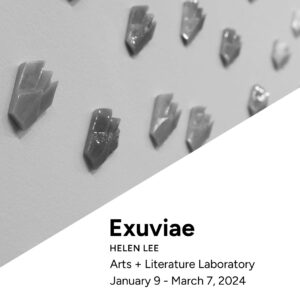The UW-Madison Glass Lab is one of UW’s treasured “firsts”—the first collegiate glass program in the nation. 2022 marked the sixtieth anniversary of this seminal narrative. In 2023-2024, the UW Glass Lab presents Glass Madison—a year-long celebration of the sixth decade of this history, composed of Exhibitions, a Symposium, and Public Programs.
 16:9–Reframing Glass with May Maylisa Cat
16:9–Reframing Glass with May Maylisa Cat
Thursday, February 29
Reception: 5-6pm
Screening: 6-8pm
Location: Chazen Museum of Art Lobby and Auditorium, 800 University Ave, Madison, WI
How can we reframe glass? Can we view it through a different lens? Emcee’d by visiting artist and critic May Maylisa Cat, 16:9—Reframing Glass is a film festival screening a diverse collection of works from UW Glass alumna, exploring themes such as: identity, culture, language, surveillance, and superstition. Centering glass and video as primary mediums, this curation also dives into performance art and materiality, showcasing the interplay between tradition and innovation. This event aims to foster an understanding of glass and see how artists are interpreting this fascinating medium anew.
16:9—Reframing Glass coincides with the Chazen Museum’s Look What Harvey Did exhibition, which is a collection of classic American Studio Glass. The Chazen exhibition foregrounds the indelible 1962 seminal narrative of American Studio Glass movement at UW-Madison, which introduced hot glass as a contemporary art medium. This event takes inspiration not only from Harvey Littleton but also from his predecessor and two-time Guggenheim awardee, Edris Eckhardt. Drawing from Eckhardt’s work, 16:9—Reframing Glass invites viewers to peer through “the looking glass”—a new lens of glass practice via video and performance—from the perspectives of femme protagonists.
16:9—Reframing Glass
Glass Madison: Exhibitions
Glass Madison Exhibitions reflect contemporary glass practice through a survey of work from the sixth decade of the UW Glass Lab, featuring current student, alumni, and faculty work.
 Exuviae
Exuviae
January 9 – March 7
Artist: Helen Lee
Opening Reception: Thursday, January 18, 6-8pm
Location: Arts + Literature Laboratory, 111 S Livingston St, Suite 100, Madison, WI
“Exuviae” refers to a sloughed-off skin, such as that of snakes, cicadas, and other exoskeleton creatures. The Latin roots of this word refer simply to “things stripped from a body.” Often transparent, exuviae commonly retain the exact appearance of the animal from which it was shed. This exhibition explores ancestry over course of migration, and what can and cannot be molted from human experience—particularly diasporic experience. Three works—Brood, Amulet, and Smoulder—triangulate the inheritances of loss and material and cultural narratives from the perspective of a second-generation Chinese-American artist. These works consider: the weight of a generational bloodline; the diffusion of a phonetic alphabet; and reverberations of the American gaze on Asian identity that grew from the oldest branch of the Chinese diaspora in America.
 Indeterminate Objects
Indeterminate Objects
January 9 – March 7
Artists: Andrew Bearnot, Stine Bidstrup, Kim Harty, and Brett Swenson
Curator: Helen Lee
Opening Reception: Thursday, January 18, 6-8pm
Location: Arts + Literature Laboratory, 111 S Livingston St, Suite 100, Madison, WI
Indeterminate Objects foregrounds the work of five artist-educators who have had significant influence in their roles as lecturers and visiting artists moving through the UW Glass Lab in the past decade: Andrew Bearnot, Stine Bidstrup, Kim Harty, Dylan Palmer, and Brett Swenson. These artists heavily informed the UW Glass Lab alumni and student work featured in this past Fall’s Glass Madison exhibitions. This exhibition further sits in dialog with the Chazen Museum’s current Look What Harvey Did exhibition—a survey of the Chazen’s personal collection of classic American Studio Glass. Unlike the era of American Studio Glass (which came to a close in the early 2000s) these artists’ work resists categorization in form, discipline, and dialog. They do not fit neatly into a growing field of material-specific exploration, but rather expand material practice into conceptually-driven and divergent trajectories.
Indeterminate Objects amplifies the sensibilities that arise from training in glassmaking processes. Vision and perception are key throughlines that precipitate from material study. Most of these works originate with a referent in the everyday—even the domestic—sphere. Yet the familiar moves through a process of keen observation spliced with fantastical imagination that calls forth the viewer’s attention in a heightened manner. These works suggest the membrane between the mundane and the magical lies in the vitreous humor of deep attention. To engage in this materially-grounded form of attention is to open up the possibility of permeability—gliding between the mundane and the magical in constant oscillation. In this way, Indeterminate Objects distort our notions of objective reality, where the power of shaping glass today is as much about the power of shapeshifting itself.


